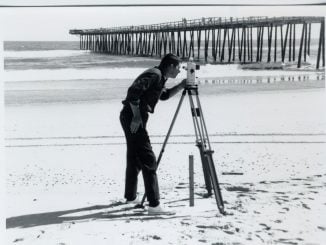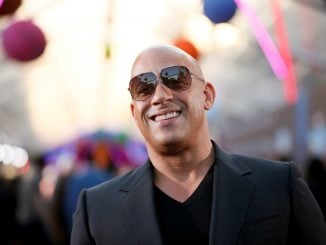
August 21, 1987
“Dirty Dancing” filmed at Lake Lure
On this day, the movie “Dirty Dancing” was released in theaters across the country.
Though set at a resort in the Catskills Mountains of Upstate New York, Dirty Dancing was shot entirely in Virginia and North Carolina. The filming came to the Southeast almost by accident. When the crew began production in September 1986, they found all the resorts in the New York mountains were closed, so they headed south. Many of the film’s most famous scenes, including the “lake lift” scene where Patrick Swayze lifts Jennifer Grey in the water, and the shots of Grey practicing her moves to the song “Wipe Out” on the stairs on a mountainside were shot at Lake Lure. The nearby Rumbling Bald Resort’s golf course was used for the scene where Grey asks her dad for money, and the Esmeralda Inn was used for interior dance shots. In 2010, the town of Lake Lure decided to begin celebrating its close association with the film by hosting the Dirty Dancing Festival. Now an annual event, the festival draws thousands to Rutherford County each August to commemorate the now classic film and raise money for pancreatic cancer research. Swayze died of pancreatic cancer in 2009 at age 57.
August 22, 1936
The nursing professing and Mary L. Wyche
Nursing pioneer Mary L. Wyche, who was chiefly responsible for establishing nursing as a profession in North Carolina, died on this day. Raised in Vance County, she went to work at Rex Hospital in Raleigh and Watts Hospital in Durham shortly after completing her medical training in Philadelphia in 1894. While at Rex in 1901, Wyche organized the Raleigh Nurses Association. The following year, she founded the North Carolina Nurses Association with 14 other nurses from around the state. During her six-year tenure as that organization’s president, Wyche persuaded the legislature to enact a law concerning the registration of nurses.
Instrumental in the founding of several nursing schools, Wyche retired from active service in 1910 to work on a history of nursing in North Carolina. The history was published two years after her death in 1936. One writer claimed, “What Clara Barton has been to America, Mary Lewis Wyche has been to North Carolina.”
August 23, 2005
Fraser fir adopted as the official state Christmas tree of North Carolina
The idea came from eighth graders at Spruce Pine’s Harris Middle School who petitioned legislators to bestow the special recognition upon the popular conifer after learning of the economic impact the tree had in the state. The bill was introduced by state Rep. Philip D. Frye, also of Spruce Pine. More than 50 million Fraser firs — known as the Cadillac of Christmas trees — are grown in North Carolina. Trees are raised in more than a dozen western counties, with Alleghany, Ashe and Avery being the top producers. North Carolina Fraser firs are known throughout the country and North America. They have been displayed in the White House on 12 occasions, more than any other species of tree.
August 24, 1901
Kenan-Flagler wedding at Liberty Hall
In 1901 Mary Lily Kenan, daughter of Capt. William Rand Kenan, married multimillionaire Henry M. Flagler at Liberty Hall in Duplin County. The home of her uncle Thomas Kenan, Liberty Hall was renovated and lavishly decorated with palms, smilax and American Beauty and Bridesmaid roses for the ceremony. Much younger than her new husband, Mary Kenan met Flagler through a mutual friend, Pembroke Jones, in Wilmington. As a wedding present for his new wife, Flagler built a 55,000-square-foot mansion in Palm Beach, Fla., where the couple lived. Liberty Hall in Kenansville is now a museum. When Flagler died in 1913, Mary Kenan Flagler became one of the wealthiest women in the United States. In 1917, not long after taking a new husband, she died from an apparent heart attack. The bulk of her fortune was left to her siblings, although a codicil to her will left her new husband $5 million.
August 25, 1774
North Carolina’s milestone move toward self-government
Sevety-one delegates were present at the roll call for North Carolina’s First Provincial Congress. It was the first such meeting held in any of the colonies. Though the rebellious Congress was held in New Bern near royal Gov. Josiah Martin’s residence at Tryon Palace, no attempt was made to stop the assembly. A month earlier, William Hooper had convened a meeting of colonists from the Cape Fear region who felt that a provincial congress, separate from North Carolina’s royal government, was urgently needed. Invitations to send delegates were dispatched and, in response, 30 counties and four towns held elections without delay. The congress, which only lasted for three days, endorsed the proposal that the colonies hold a Continental Congress. To that end, the group selected William Hooper, Joseph Hewes and Richard Caswell as delegates to that convention. Aside from revolutionary topics, the delegates also discussed basic rights and responsibilities of government. They were eager to exercise control over North Carolina’s affairs. The concluding pledge to support the actions of the forthcoming Continental Congress was a testament to their goal of self-government and to their preparedness to achieve that goal.
August 28, 1898
“Pepsi-Cola” got its name
Beginning in 1893, New Bern pharmacist Caleb Bradham developed and began serving a carbonated drink he called “Brad’s Drink.” He served the beverage from the soda fountain in his pharmacy at the corner of Pollock and Middle streets. As a pharmacist who had undergone some medical training, Bradham believed in the health, energy and digestive benefits of his sweet and bubbly brew, which originally included the enzyme pepsin and the cola nut. After the renaming, Bradham managed to purchase the trade name “Pep Cola” from a New Jersey company and, in 1902, he incorporated the Pepsi-Cola Company under North Carolina law. Shortly thereafter he registered a patent for the formula. From there the business quickly grew. By 1910, the beverage was being bottled at more 300 companies in 24 states. A combination of factors — including fluctuations in sugar prices and supply, imperfect bottling technology and poor marketing — resulted in a failing business after World War I, and Bradham was forced to sell the company.



